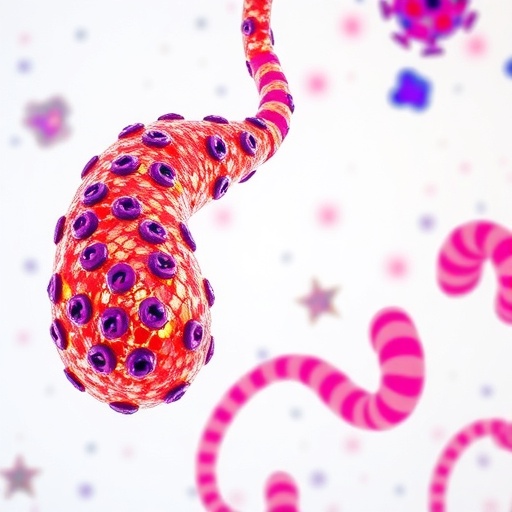In the relentless quest to enhance cancer treatment and personalize patient care, recent advancements have spotlighted the successful integration of immunotherapy and precision medicine. A groundbreaking study published in BMC Cancer unravels the intricate immune landscapes characterizing patients with unresectable hepatocellular carcinoma (uHCC) who derive meaningful benefits from the combination of pembrolizumab and lenvatinib. By employing sophisticated machine learning algorithms on immune cell profiles, researchers have laid a foundation for predictive diagnostics that could revolutionize therapeutic strategies for this notoriously challenging cancer.
Hepatocellular carcinoma ranks among the most fatal malignancies worldwide, often diagnosed at advanced stages where surgical options become nonviable. Immunotherapies, particularly immune checkpoint inhibitors like pembrolizumab, have ushered in new hope. When combined with lenvatinib, a multi-kinase inhibitor, patients exhibit improved outcomes, yet variability in response remains an unresolved clinical conundrum. Until now, the ability to forecast which individuals will benefit from such dual treatment regimens has been limited.
To confront this dilemma, a multidisciplinary team prospectively enrolled 51 patients with unresectable hepatocellular carcinoma between mid-2019 and mid-2023. Prior to initiating pembrolizumab-lenvatinib (PL) therapy, comprehensive peripheral blood samples were taken to map immune cell constituents in unprecedented detail. The team then meticulously monitored tumor response following RECIST 1.1 criteria to objectively stratify participants into responders and non-responders.
Intriguingly, 16 patients demonstrated objective tumor response, signaling significant reduction or stabilization of their disease, while 11 exhibited clear signs of tumor progression despite therapy. Detailed immunophenotyping revealed that responders possessed markedly elevated levels of total T cells and specifically CD8+ cytotoxic T cells, which are instrumental in targeting and eradicating malignant cells. Moreover, these patients showed enriched populations of PD-1-expressing subsets within CD4 and CD8 T cells, as well as natural killer (NK) cells, indicative of an activated yet regulated immune milieu conducive to tumor suppression.
In stark contrast, non-responders displayed a peculiar predominance of PD-L1-positive monocytes—immune cells that can contribute to an immunosuppressive tumor microenvironment by dampening anti-tumor immune responses. This dichotomy underscores the complex interplay of immune activation and suppression within the tumor-host interface and suggests that the balance of these cell types significantly influences therapeutic efficacy.
Capitalizing on these findings, the investigators constructed a machine learning model fueled by baseline immune cell profile data. This artificial intelligence-powered system demonstrated astonishing predictive power, achieving perfect sensitivity—catching every patient who would respond to treatment—while maintaining reasonable specificity. Notably, CD8+ T cells, PD-1+ CD8 NK cells, and PD-L1+ monocytes emerged as critical variables steering the model’s classification outcomes.
Such a paradigm of harnessing machine learning to parse multidimensional immunological data exemplifies the future of oncology diagnostics. Beyond simple biomarker detection, these algorithms integrate complex datasets to unveil subtle yet clinically meaningful patterns, empowering clinicians to tailor therapy with unprecedented precision. Implementation in clinical settings could spare patients from ineffective treatments, reduce adverse events, and optimize resource allocation.
The study further validates the concept that immune phenotyping of peripheral blood, an accessible and minimally invasive procedure, can faithfully reflect tumor immune dynamics. This is a significant leap as tumor biopsies, often fraught with sampling challenges and patient risk, have traditionally been the mainstay for such insights. The ability to leverage blood-based immune signatures heralds a new era of real-time monitoring and adaptable therapy adjustment.
While the efficacy of pembrolizumab and lenvatinib has been documented, prior efforts to predict patient outcomes relied mostly on clinical indicators and tumor genomic markers with limited success. By contrast, this study’s focus on immune cell populations and their functional states, combined with computational analysis, offers a more granular and functional perspective, directly tied to the immune system’s capacity to counteract cancer.
Looking ahead, integrating this machine learning approach with other modalities such as imaging, genetic profiling, and cytokine analyses could further refine prediction models. In addition, expanding sample sizes and validating findings across diverse populations and cancer subtypes will be crucial steps toward widespread clinical adoption.
These insights also raise compelling biological questions regarding whether modulation of PD-L1+ monocytes or enhancement of PD-1+ T and NK cells could serve as therapeutic targets themselves. The immunological tug-of-war observed here hints at potential avenues for combination strategies that not only employ checkpoint inhibitors but also calibrate innate immune cell functions.
Moreover, the importance of CD8+ T cells and specific NK cell subsets aligns with a growing appreciation of cytotoxic lymphocytes as frontline warriors against tumors. Understanding factors that govern their abundance, exhaustion status, and functional competence will be vital for advancing immunotherapy.
In parallel, the study’s demonstration that peripheral blood immune profiling can successfully classify patients into clinically relevant response categories paves the way for predictive biomarkers that are both practical and highly informative. With further refinement, such tools could be seamlessly integrated into routine oncology practice, enabling a precision medicine approach truly tailored to individual immunobiology.
In conclusion, this collaborative research represents a landmark achievement in characterizing immune landscapes that dictate responsiveness to combination immunotherapy in hepatocellular carcinoma. By marrying detailed immunophenotyping with cutting-edge machine learning, it charts a promising path toward predictive diagnostics and personalized treatment paradigms for patients battling this formidable disease. The future of cancer care, illuminated by such innovations, holds promise not only for enhanced survival but also for improved quality of life.
Subject of Research: Immune profiling in unresectable hepatocellular carcinoma patients undergoing pembrolizumab and lenvatinib therapy.
Article Title: Characterizing immune profiles in hepatocellular carcinoma patients benefiting from pembrolizumab and lenvatinib using machine learning
Article References:
Lee, PC., Li, PY., Lee, CY. et al. Characterizing immune profiles in hepatocellular carcinoma patients benefiting from pembrolizumab and lenvatinib using machine learning. BMC Cancer 25, 1641 (2025). https://doi.org/10.1186/s12885-025-14945-9
Image Credits: Scienmag.com
DOI: https://doi.org/10.1186/s12885-025-14945-9
Keywords: Hepatocellular carcinoma, pembrolizumab, lenvatinib, immune profiling, machine learning, immunotherapy, CD8 T cells, PD-1, PD-L1, natural killer cells, predictive biomarkers




